Spiders are a diverse group of arachnids that are found in nearly every habitat on Earth. According to University of Florida, there are over 40,000 species of spider in the world known to science, about 1,200 of which may be found in the United States.
While many people are familiar with the common black and brown spiders that can be found in and around homes, white spiders are a lesser-known group that are often overlooked.
Let us talk about the different types of white spiders that exist and their unique characteristics. While at it, try to examine the various habitats where white spiders can be found, and how they adapt to their surroundings to survive and thrive.
List of White Spiders
- White Crab Spider (Thomisus spectabilis)
- Spinybacked Orb Weaver Spider (Gasteracantha cancriformis)
- Goldenrod Crab Spider (Misumena vatia)
- Arctic wolf spider (Pardosa glacialis)
- White-jawed Jumping Spider (Hentzia mitrata)
- White Lady Spider (Leucorchestris arenicola)
- American green crab spider (Misumessus oblongus)
- White banded crab spider (Misumenoides formosipes)
- Gray wall jumping spider (Menemerus bivittatus)
- White Micrathena (Micrathena mitrata)
- Striped lynx spider (Oxyopes salticus)
- Kidney garden spider (Araneus mitificus)
- White-backed Garden Spider (Argiope trifasciata)
- Oblong running spider (Tibellus oblongus)
- Hump-backed orb weaver (Eustala anastera)
Description and Facts
White Crab Spider

The White Crab Spider, also known as Thomisus spectabilis or Australian crab spider has a white coloration, although it may sometimes exhibit a yellow hue.
It is called crab spiders because of its unique ability to walk sideways as well as forwards and backwards. Its legs and head have a nearly translucent appearance. Females are usually larger than males and can grow up to 10mm in length.
These spiders have two large, crab-like front legs that are used for grasping prey, while the other six legs are used for walking. The spiders are commonly observed resting in flowers that match its own color. They are most commonly found on plants such as goldenrod, daisies, and sunflowers.
Female White Crab Spiders lay their eggs on near plants that they inhabit. The eggs hatch into spiderlings, which look like miniature adults. The spiderlings will molt several times before reaching adulthood.
White Crab Spiders are sit-and-wait predators that ambush their prey. Once the prey is within reach, the spider will quickly grasp it with its powerful front legs and inject it with venom. They eat bees, butterflies and other small flying insects that visit the flowers they have colonised.
Facts Table
| Scientific Name | Thomisus spectabilis |
| Other Names | Australian crab spider |
| Female Body Length | Up to 10 mm |
| Male Body Length | Up to 6.2 mm |
| Nature | Suburban spider |
| Predators | Birds, lizards and other spiders. |
| Food | Crickets, bees, drosophila flies, butterflies, |
| Hunting technique | Camouflage |
| Do they build webs | No. |
| Where are they found? | Eastern Australia |
Also Read: Different Types of Gnats
Spineybacked orb weaver spider
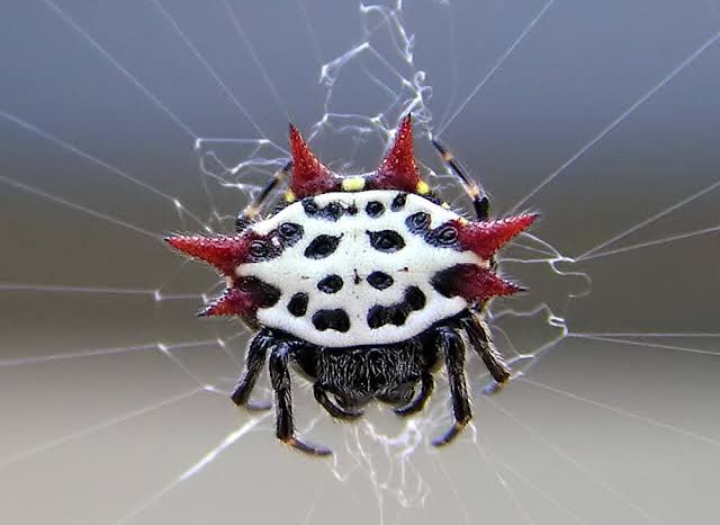
The spineybacked orb weaver spider, also known as the crab-like orbweaver and the spiny orbweaver, derives its common name from the spines that extend from its abdomen and its body structure that look-like that of a crab.
Its body is round or crab-like in shape. The abdomen is creamy-white, with black spots and red spines. The legs are black and adorned with sharp white spines. The spines on the spider’s back are thought to serve a protective function, warding off potential predators.
Males are much smaller than females. Females measure around 6 to 9 mm in length, while males measure between 3 to 4 mm in length.
The spider use web to catch prey, waiting patiently at the center for unsuspecting insects to become entangled. It preys on small insects like flies, moths and beetles.
The Spinybacked Orb Weaver Spider is a solitary spider and does not live in groups. It is active during the daytime and rests at night.
The primary predators of the Spinybacked Orb Weaver Spider are birds and other insectivores that may accidentally fly into their webs.
According to University of Florida. After mating, the female lays her eggs in a sac-like structure that she attaches to her web. The eggs will hatch into spiderlings that will disperse and create their webs as they mature. The spider has one to three generations per year.
Facts Table
| Scientific Name | Gasteracantha cancriformis |
| Other Names | Crab-like orbweaver or Spiny orbweaver |
| Female Body Length | 6 to 9 mm |
| Male Body Length | 3 to 4 mm in length |
| Habitat | Gardens, Forests and Grasslands |
| Predators | Birds and other insectivores |
| Food | Flies, moths and beetles etc |
| Hunting technique | Web building |
| Do they build webs | YES |
| Where are they found? | Central and South America, the Caribbean and parts of southern North America. |
Goldenrod Crab Spider
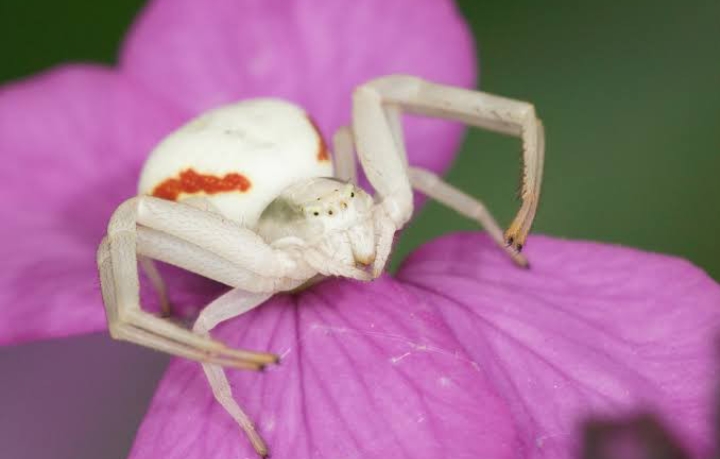
The Goldenrod Crab Spider, scientifically known as White Caribbean crab spiders. It can be yellow or white and can change back and forth. Their default color is white. The spider has a flattened body with two large front legs that are used to grasp its prey. It is commonly found on goldenrod flowers, hence its name.
The male is smaller than the female and is somehow darker in color. Females grow to about 10 mm long and the male grow to about 6 mm long. Young goldenrod crab spiders look like their parents, but are much smaller.
They Golden Crab spider is a “sit and wait” or “ambush” hunter. Instead of spinning webs to catch the prey like many spiders do, it just relies on its camouflage. It feeds on insects particularly bees, wasps and flies.
It is usually found on goldenrod flowers, as well as on other types of flowers such as daisies, sunflowers and asters. This spider is also common on fruit trees and shrubs.
When threatened, the Goldenrod Crab Spider will usually try to escape, but if cornered, it will use its front legs to defend itself.
Facts Table
| Scientific Name | Misumena vatia |
| Other Names | White Caribbean crab spiders |
| Female Body Length | Up to 10 mm |
| Male Body Length | Up to 6 mm |
| Habitat | Fields, meadows, gardens and forests |
| Predators | Birds, other spiders and some insects. |
| Food | Bees, wasps and flies. |
| Hunting technique | Camouflage |
| Do they build webs | No. |
| Where are they found? | North America and Caribbean |
Also Read: Different Types of Green Spiders
The Arctic Wolf Spider
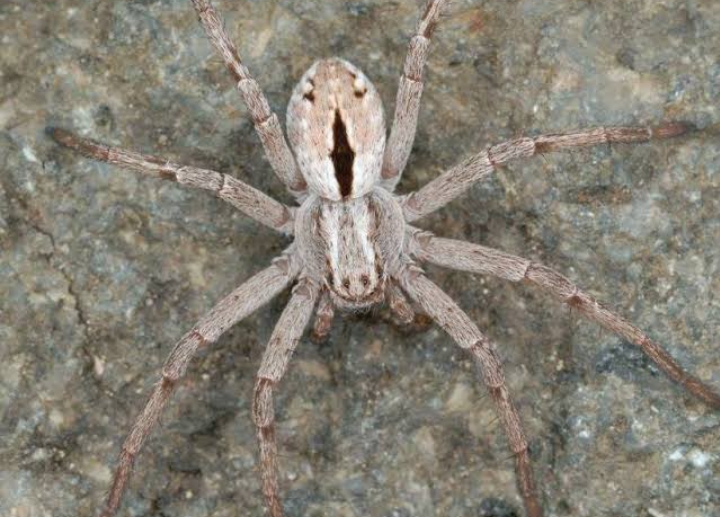
The Arctic Wolf Spiders have a dark brown coloration with white hairs on the body and legs. They are found in the Arctic tundra particularly Greenland, where they can be located on the ground, on rocks, and on vegetation (shrubs, grasses, mosses, sedges and lichens).
The males are smaller than females, and both sexes have long, spiny legs that help them move easily over snow and ice. The legs are eight arranged in four pairs.
These spiders are active during the summer months. During the winter, they burrow into the snow or seek shelter in rocky crevices. They are solitary creatures and do not form colonies or nests. They are also nocturnal creatures and are most active at night.
The female Arctic Wolf Spiders mate and lay their eggs in late summer or early fall. It constructs a spherical egg sac made of silk, which she attaches to her spinnerets and carries with her until the eggs hatch. The spiderlings come out from the egg sac in the spring and goes through a number of molts before reaching adulthood.
Facts Table
| Scientific Name | Pardosa glacialis |
| Other Names | Snow Spider |
| Female Body Length | 2.1 inches |
| Male Body Length | 1.6 inches |
| Habitat | Areas with permanent snow cover. |
| Predators | Birds such as Snowy Owls and other predators, such as foxes, wolves and weasels. |
| Food | Insects such as flies, mosquitoes, and other small invertebrates. |
| Hunting technique | Hiding and chasing the prey |
| Do they build webs | No. |
| Where are they found? | Tundra particularly Greenland. |
White-jawed Jumping Spider
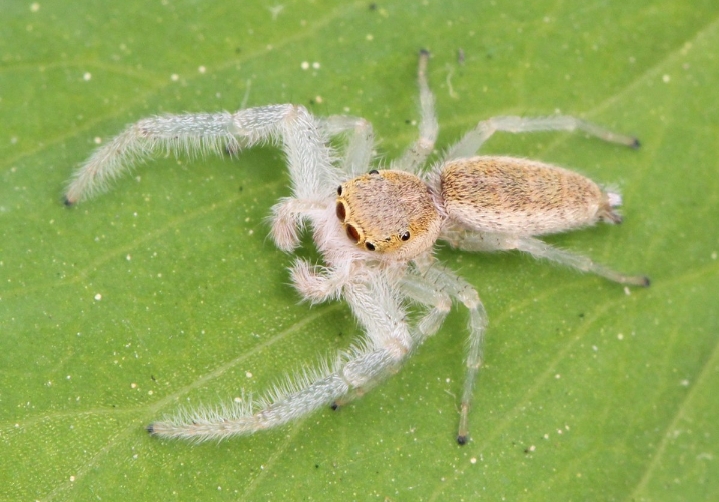
The White-jawed Jumping Spider has a light brown body with white stripes on their jaws. The legs of this spider are also banded with white and brown stripes. The adult spiders grow up to around 5 to 18 millimeters in length.
Their front legs are usually thicker and somewhat longer than their other legs. They are capable of very agile jumps hence the name jumping spider.
They have eight eyes, arranged in two rows of four. The front row of eyes is particularly large. The spiders are active during the day and sometimes curious and unafraid of humans. They can also be territorial and may engage in aggressive behavior towards other spiders.
In North America, they are commonly found in residential areas, particularly around gardens and homes with vegetation.
Facts Table
| Scientific Name | Hentzia mitrata |
| Other Names | Hentzia mitrata |
| Female Body Length | 10-18 mm |
| Male Body Length | 5-12 mm |
| Habitat | Forests, swamps, home gardens and marshes. |
| Predators | Birds, lizards and larger spiders. |
| Food | Flies, mosquitoes and beetles |
| Hunting technique | Hiding and chasing the prey |
| Do they build webs | No. |
| Where are they found? | United States, Canada and Bahama Islands |
The White Lady Spider

The White Lady Spider is pear-shaped with creamy-white abdomen and long, legs that are covered in fine white hairs. Their legs are nearly twice the size of the body. Because of their creamy shade and dancing or rather tapping movements, they are known as the dancing white lady.
The White Lady Spider is a larger spider species, with females measuring between 4 and 5 inches in body length, while males are comparably smaller.
The Spider is found exclusively in the Namib Desert of Namibia and Angola. In this place, the spider lives in underground burrows, which it constructs using its powerful front legs.
This spider is most active at night. During the day, it remains hidden in its burrow to avoid the intense heat and sunlight of the desert. It is also able to quickly retreat back into its burrow if it senses danger.
Also Read: Types of Purple Spiders
Facts Table
| Scientific Name | Leucorchestris arenicola |
| Other Names | Dancing white lady spider |
| Female Body Length | 4 to 5 inches |
| Male Body Length | 3 to 4 inches |
| Habitat | Desert |
| Predators | Birds, reptiles and larger arthropods |
| Food | Insects and small arthropods. |
| Hunting technique | Hiding and chasing the prey |
| Do they build webs | No. |
| Where are they found? | Namib Desert of Namibia and Angola |
American green crab spider
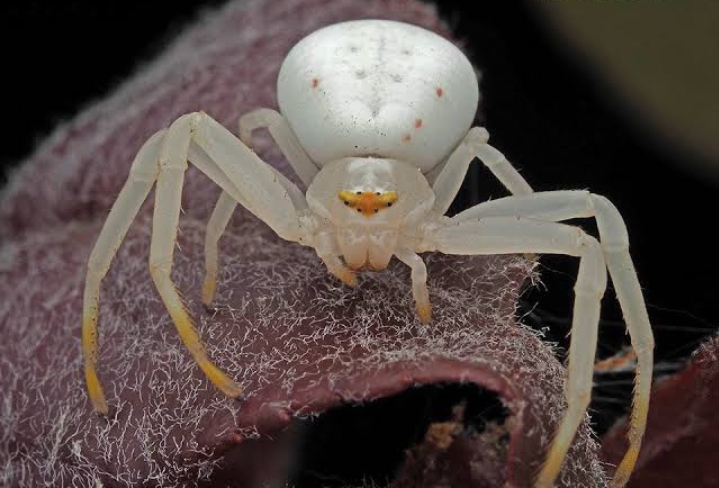
American green crab spider also referred to as Green crab spider, is a small bristly spider. The females are larger than males and can reach a length of up to 10 mm, while males measure up to 7 mm in length.
The abdomen is flattened, broadly oval, and widest near the rear. It is usually white, often pale yellow, sometimes creamy-white. There are sometimes broad red bands on the lateral margins. The front two pairs of legs are thicker and much longer than the others, and are normally held out and forward, like a crab.
These spiders are active hunters and are often seen running quickly across leaves and flowers in search of prey. They have a sharp eyesight and are able to detect movement of prey from far. They are not aggressive towards humans and will usually try to flee if they feel threatened.
Green crab spiders are found throughout much of North America, from southern Canada to United States to Mexico. They can be found in a variety of habitats, including fields, gardens, meadows, and forest edges.
Facts Table
| Scientific Name | Misumessus oblongus |
| Other Names | Green crab spider |
| Female Body Length | Up to 10 mm |
| Male Body Length | Up to 7 mm |
| Nature | Diurnal |
| Predators | Birds, reptiles and larger spiders |
| Food | Flies, bees and grasshoppers. |
| Hunting technique | Hiding and chasing the prey |
| Do they build webs | No. |
| Where are they found? | North America, from southern Canada to United States to Mexico. |
White banded crab spider

The white-banded crab spider has white stripes on its body. It has eight legs and two large front legs that resemble crab claws. The spider’s body is relatively flat and wide. The abdomen is oval-shaped. The female spider is much larger than the male.
The female can be about 8 to 12 mm, while males can be 6 to 10 mm in length. The pattern of markings on females can vary greatly. It can change between white and yellow dependent on the color of their surroundings. The males differ from females in that their four front legs are darker and the abdomen is gold.
The white-banded crab spider is an ambush predator. When an unsuspecting insect comes near, the spider will quickly pounce and use its powerful front legs to subdue the prey. It then injects venom into the prey to immobilize it and begins to feed.
This spider has a preference for nectar-feeding insects. Some of the common prey include bees, flies, moths, butterflies and other small insects that visit flowers.
Facts Table
| Scientific Name | Misumenoides formosipes |
| Nature | Diurnal |
| Female Body Length | Up to 12 mm |
| Male Body Length | Up to 10 mm |
| Environment | Garden and forests |
| Predators | Other spiders, birds, lizards and other small animals that hunt insects |
| Food | Bees, flies, moths and butterflies etc. |
| Hunting technique | Ambush and Active hunting |
| Do they build webs | No. |
| Where are they found? | Africa, Asia, North America from Canada to United States to Mexico. |
The Gray wall jumping spider

The Gray wall jumping spider body is covered with short, fine hairs, which give it a velvety appearance. The coloration of the spider is grayish-brown, with white stripes running parallel to each other on the cephalothorax (head and thorax combined).
The female is slightly larger than the male. The male has a blackish longitudinal dorsal stripe with a brownish-white stripe on either side of the abdomen. The female is generally paler and browner, with a larger carapace and abdomen.
The spider’s legs are long and slender, with the first pair of legs being longer and thicker than the other three pairs. The first pair of legs is used for jumping and grasping prey. The spider’s eyes are located on the front of its head and are very large in proportion to its body size.
The spiders is not venomous and do not produce silk to capture prey. It just relies on its jumping ability to catch food. It is very good hunter and sometimes catches prey that is much larger than itself.
The spider is found in many regions of the world such as Africa, Asia and Australia. It prefers warm and humid habitats, such as gardens, forests and urban areas.
Facts Table
| Scientific Name | Menemerus bivittatus |
| Nature | Diurnal |
| Female Body Length | Up to 14 mm |
| Male Body Length | Up to 12 mm |
| Spiderlings | Immature spiders resemble the female |
| Predators | Geckos, anoles, birds etc |
| Food | Flies, mosquitoes, ants, and other small insects. |
| Hunting technique | Ambush and active hunting |
| Do they build webs | No. |
| Where are they found? | North America, Africa, Asia and Australia |
White Micrathena

The body of the White Micrathena is roughly oval in shape. The upper surface of the body is white with black stripes running down the center. The white abdomen bulges out the sides and comes to two sharp points by the rear end.
The ventral surface of the abdomen is pale yellow and can be cream-colored as well. The legs are long and slender, with a black or brown coloration. The first and second pairs of legs are longer than the third and fourth pairs.
The head region is black with a pair of small, forward-facing mouthparts. The spider’s eight eyes are positioned on the anterior portion of the cephalothorax, with two large eyes in the center and six smaller eyes arranged around them.
At the tip of its abdomen, it has several pairs of spinnerets, which produce silk for web-building and wrapping prey. The spider also has venom glands that produce venom to subdue and kill its prey.
These spiders are skilled hunters. They use their good eyesight and sense of touch to detect vibrations in the web caused by struggling prey. Once detected, the spider quickly moves to the prey and injects it with venom from its chelicerae.
Facts Table
| Scientific Name | Micrathena mitrata |
| Nature | Diurnal |
| Female Body Length | Up to 10 mm |
| Male Body Length | Up to 8 mm |
| Habitat | Coniferous forests and other habitats such as gardens and parks. |
| Predators | Birds, larger spiders and insect predators such as assassin bugs and mantises. |
| Food | Flies, mosquitoes, ants, and other small insects. |
| Hunting technique | Ambush and Web trap |
| Do they build webs | YES |
| Where are they found? | North America, Africa, South America, Asia and Australia |
Striped lynx spider
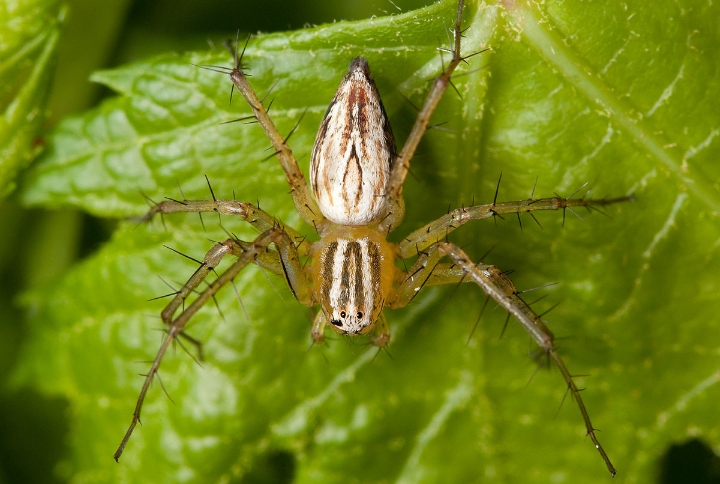
The spider is named because of the striped pattern on its body, which is made up of two broad stripes running down the length of the body, and several thinner stripes on the sides. It has a long or elongated abdomen that tapers towards the back end of the body.
It also has a unique eye arrangement of six similarly sized eyes that create a hexagon at the top of the head region and another pair of smaller eyes under this hexagon on the front of the face.
The spider is active during the day and rests at night. It hunts on the ground for other spiders and insects. Its habitat tends to be grasses and leafy vegetation; grassy, weedy fields, and row crops.
The Striped Lynx Spider can be found in many parts of the world like North America, Europe, Africa and Asia. In North America, it is found from Canada to Mexico, and in Europe, it is found throughout the continent. [Source: University of Maine]
Facts Table
| Scientific Name | Oxyopes salticus |
| Nature | Diurnal |
| Female Body Length | Up to 9 mm |
| Male Body Length | Up to 6 mm |
| Habitat | Yards, grassy, weedy fields and row crops |
| Predators | Birds, larger spiders and insect predators such as assassin bugs and mantises. |
| Food | Flies, mosquitoes, ants, grasshoppers and beetles |
| Hunting technique | Ambush |
| Do they build webs | YES |
| Where are they found? | North America, Africa, South America, Asia and Australia |
Kidney garden spider
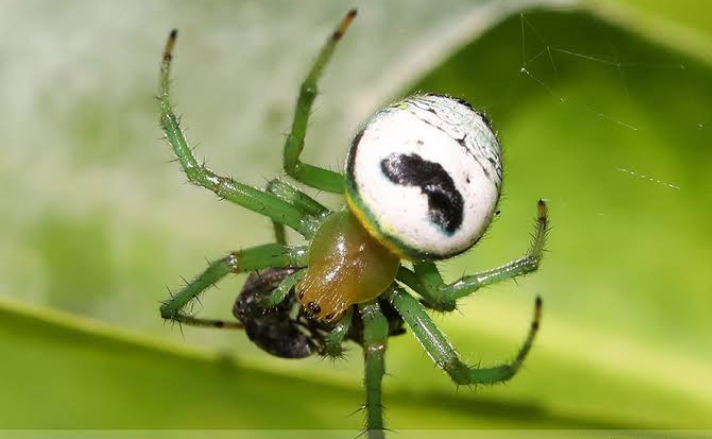
The spider has two main body parts: the cephalothorax (the fused head and thorax) and the abdomen. The cephalothorax is covered in bristly hairs and has eight eyes arranged in two rows of four. It has a body length of around 10 to 14 mm. Females are usually larger than males.
The abdomen is large and kidney-shaped with a slightly pointed tip. It is usually brown with patterns of white and black markings. The underside of the abdomen is lighter in color and doesn’t have markings.
The legs of the this are long and slender, with black and yellow banding. The first pair of legs is the longest and is used for grasping and wrapping prey.
The Kidney Garden spider is an orb-weaving spider (makes a circular web with radial threads that connect to a central hub). When an insect lands on the web, it becomes stuck in the sticky silk and struggles to break free. The spider can detect the vibrations of struggling prey and quickly moves to capture it.
Facts Table
| Scientific Name | Araneus mitificus |
| Nature | Diurnal |
| Female Body Length | Up to 14 mm |
| Male Body Length | Up to 10 mm |
| Habitat | Open areas with vegetation, such as meadows, hedgerows and along woodland edges. |
| Predators | Birds, wasps, Praying mantids, other spiders and small mammals. |
| Food | Moths and butterflies, Insects, Small vertebrates, other spiders and other arthropods. |
| Hunting technique | Ambush and web trap |
| Do they build webs | YES |
| Where are they found? | North America, Africa, South America, Asia and Australia |
Also Read: Difference Between Spider And Tarantula
The whitebacked garden spider
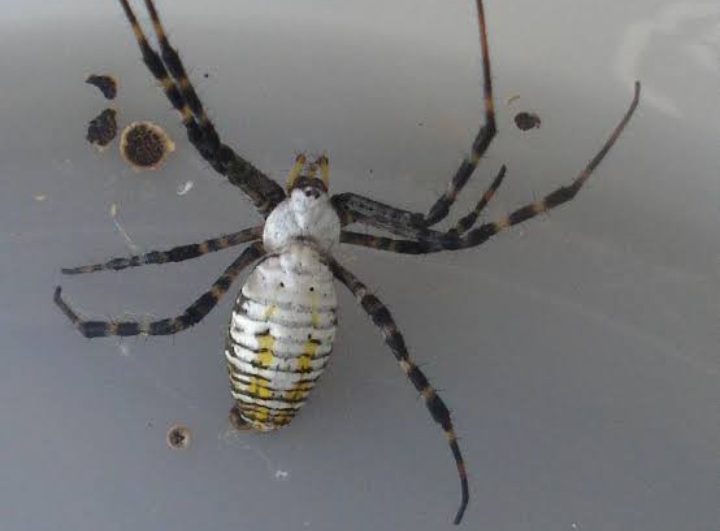
The whitebacked garden spider has a round, bulbous abdomen that is covered in bristles and marked with white or cream-colored band across the middle. The rest of the spider’s body is black or dark brown in color with long, spiny legs and a small, triangular-shaped head.
The back of the spider is covered with silvery setae. Numerous dark lines cross the body and yellow banding is usually present as well. The legs are dark yellowish-brown with darker rings.
Females are larger and more brightly colored than males. Mature females may be about 14 mm when fully extended whereas the males may be about 10 mm.
Adult males also have prominently enlarged pedipalps projecting from the side of the head and these are used in sperm transfer.
The whitebacked garden spider is an orbweaver spider and produces large concentrically patterned web in areas of tall grass and shrubby vegetation. The web is sticky and strong, capable of holding fairly large and active insects such as wasps and grasshoppers.
These spiders are most active during the day. Their primary prey consists of flying insects such as butterflies, moths and bees. They also eat small vertebrates, small spiders and arthropods.
Facts Table
| Scientific Name | Argiope trifasciata |
| Nature | Diurnal |
| Female Body Length | Up to 14 mm |
| Male Body Length | Up to 10 mm |
| Habitat | Open areas with vegetation. |
| Predators | Birds, wasps, Praying mantids, other spiders and small mammals. |
| Food | Moths and butterflies, Insects, Small vertebrates, other spiders and other arthropods. |
| Hunting technique | Ambush and web trap |
| Do they build webs | YES |
| Where are they found? | Southeastern United States, Mexico and Central America. |
Oblong running spider
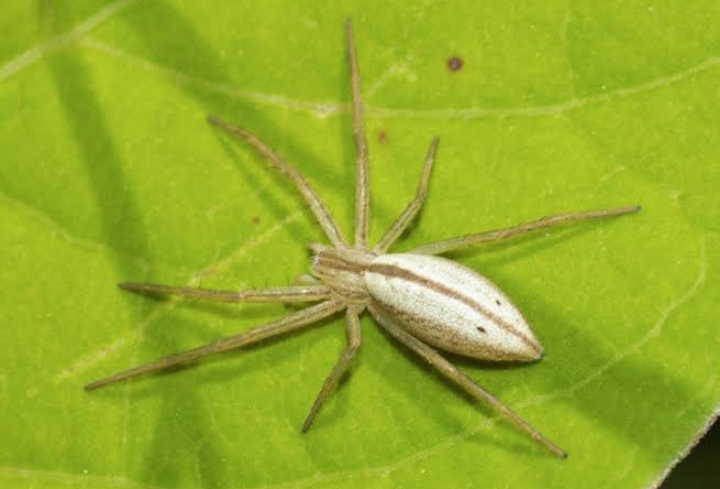
Oblong running spider is a medium-sized spider, with a slender, elongated body that is flattened and broadened in the cephalothorax (head and thorax) region. It is by far the most common slender crab spider.
The spider’s body is yellowish-brown or creamy-white in color, with darker stripes and spots on the abdomen. The color of spider can changes in relation to the environment it is in, with some individuals being much darker or lighter than others.
The spider’s legs are long and thin, covered in short, dense hairs. The front legs are longer than the other legs and are used to grasp prey, while the hind legs are used for propulsion and steering. Also, it has four pairs of eyes, with the two front pairs being the largest and most prominent.
The spider is an active hunter, it does not build a web to catch prey, but instead relies on its quick reflexes and agility to capture prey on the ground or in vegetation. It preys on small insects such as flies, beetles and other spiders.
Oblong running is a widespread spider. It occurs throughout much of Europe, Asia and North America. In United States its commonly abundant in Mississippi and Minnesota. It is easily seen running across the ground or climbing plants in search of prey. [Source: University of Minnesota Extension]
Facts Table
| Scientific Name | Tibellus oblongus) |
| Nature | Diurnal |
| Female Body Length | Up to 12 mm |
| Male Body Length | Up to 10 mm |
| Habitat | Meadows, fields and grassy habitats |
| Predators | Birds, wasps, Praying mantids, other spiders and small mammals. |
| Food | Moths and butterflies, Insects, Small vertebrates, other spiders and other arthropods. |
| Hunting technique | Active hunting |
| Do they build webs | NO |
| Where are they found? | Europe, Asia, Africa and North America |
The Hump-backed orb weaver
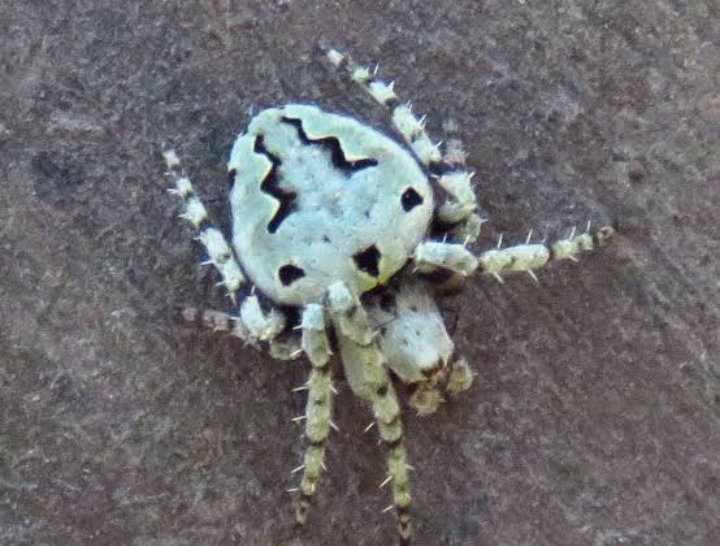
This spider is named so, because of its hump-shaped abdomen. The hump is formed by the spider’s thorax being elevated upwards, creating a bulge on its back. This unique characteristic makes it easy to identify the spider anywhere.
The spider has a small cephalothorax (combined head and thorax region) and eight long and slender legs. The legs are covered in fine hairs which are most notable in males.
The spider’s color varies, with the dorsum (upper surface) of its abdomen being light yellow or creamy-white with dark markings, while its ventral (lower) surface is light with brown, white or yellow stripe. The spider’s appearance may appear different based on the environment it is found in.
The female is always larger than the male, with a body length of up to 15 mm, while males are 8 mm in length. Females also have a larger abdomen compared to the male. The spider’s eyes are arranged in two rows of four, with the two central eyes being larger than the rest.
This spider spins a large, intricate web that it uses to capture prey. The spider is most active at night and is attracted to light. It is a solitary species, and individuals are territorial and will defend their webs aggressively against intruders.
Facts Table
| Scientific Name | Eustala anastera |
| Nature | Nocturnal |
| Female Body Length | Up to 15 mm |
| Male Body Length | Up to 8 mm |
| Habitat | Forests, savannas and grasslands. |
| Predators | Birds, wasps, Praying mantids, other spiders and small mammals. |
| Food | Moths and butterflies, Insects, Small vertebrates, other spiders and other arthropods. |
| Hunting technique | Web spinning |
| Do they build webs | YES |
| Where are they found? | Tropical and subtropical regions of South and Central America (Brazil, Argentinasss and Costa Rica). |